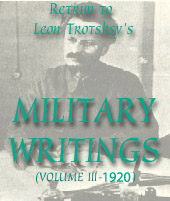
Listen, workers; listen, peasants; listen, Red Army men.
Yet another perfidious knife has been raised to strike at you. The Polish gentry and bourgeoisie have begun a war against us. We, the workers’ and peasants’ government, did everything we could to avoid further bloodshed. We ordered the Red troops not to advance. From the very start we frankly and honestly recognised the independence of Poland. In neither word nor deed have we encroached on her territory. We were ready to make great concessions and sacrifices. We offered Poland an immediate general armistice along the whole front. But nowhere in the world is there a bourgeoisie greedier, more corrupt, insolent, frivolous and criminal than the gentrified bourgeoisie of Poland. The Warsaw adventurers saw our honest love of peace as weakness. The Polish Government announced that they wished to ‘liberate’ the Ukraine – that is, to occupy that country with their own forces, deprive it of independence, enslave, crush and crucify it, give the land back to the Polish landlords and turn the Ukrainians into slaves. Byelorussia and Lithuania are already groaning under the Polish landlords’ yoke. A blow has now been aimed at the Ukraine. [2] And at the same time the Polish bourgeoisie demands Russian land almost as far as Smolensk itself. Tens of millions of Ukrainian and Russian proletarians and peasants are to become beasts of burden for these robber grandees.
But this shall not be! All of us – workers, peasants, soldiers, citizens of the great country which, first in all the world, smashed the chains of bourgeois slavery – we all, as one man, will swear to defend the Soviet Republic from the unbridled Polish bands. The rebuff we shall give will be merciless and irresistible. Death to the Polish bourgeoisie. Over its corpse we shall conclude a fraternal alliance with workers’ and peasants’ Poland.
1. For the complex and controversial details, military and diplomatic, of the Soviet-Polish conflict of 1919-1920, see P.S. Wandycz, Soviet-Polish Relations, 1917-1921 (1969) and Norman Davies, White Eagle, Red Star (1972). For its repercussions in Western Europe, see E.M. Carroll, Soviet Communism and Western Opinion, 1919-1921 (1965) and R.H. Ullman, History of Anglo-Soviet Relations, 1917-1921, Vol.3: The Anglo-Soviet Accord (1972). – B.P.
2. Throughout the winter of 19l9-1920 Poland carried on active preparation for a spring offensive against the Soviet Republic, which, having emerged from the fronts of the civil war, was undertaking partial demobilisation and transferring a number of armies to labour duty (see note 11.) Pilsudski decided to strike his main blow at the Ukraine, with the ultimate aim of annexing the whole of the country lying on the right bank of the Dnieper. The agreement signed by Pilsudski with Petlyura for a Polish-Ukrainian federation also influenced his choice of main operational direction. In mid-April 1920 the Red Army on the Western frontier was disposed over a wide front, from Lake Osveya [Lake Osveya is near the border between Byelorussia and Latvia. Litin is about 20km. north-west of Vinnitsa.] to the Dniester. This front was held by the 15th and l6th Armies of the Western front and the 12th Army of the South-Western front. On April 25, taking advantage of their substantial superiority on the Ukrainian sector of the front (60,000 bayonets and l1,000 sabres against 15,000 bayonets and 3,500 sabres), the Polish army launched an offensive towards Kiev and Odessa (see map No.2).

Last updated on: 26.12.2006